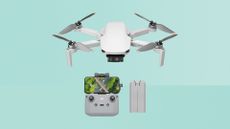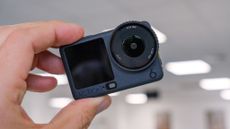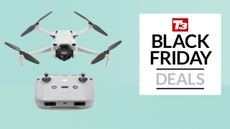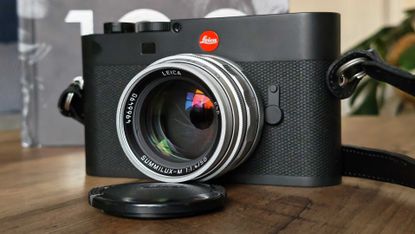Cameras
The latest Cameras breaking news, comment, reviews and features from the experts at T3
Explore Cameras
-

Best Boxing Day DJI drone sales – experts select the best buys in the sale
Should you buy a new DJI this Boxing Day? Yes, you should.
By Matt Kollat Published
-

Beginner-friendly DJI Neo 4K selfie drone crashes to its cheapest price ever for Boxing Day
The dinky drone is selling for peanuts this Christmas
By Matt Kollat Published
-

DJI's beginner 4K drone bargain returns for Boxing Day at its lowest price yet
Perfect first drone crashes back down to Black Friday pricing for Christmas
By Matt Kollat Published
-

DJI's free software update gives its flagship action camera a massive resolution upgrade and focus peaking
8K video, focus peaking, and cloud uploads land on the Osmo Action 6
By Matt Kollat Published
-

Run, don’t walk – Currys has slashed the price of this five-star DJI drone bundle
The Mini 4 Pro is a sub 250g drone with pro features
By Bryony Firth-Bernard Published
-

DJI’s 360º camera just got much better at social video thanks to a free software update
The Osmo 360 just learned a few new tricks
By Matt Kollat Published
-

Best budget action camera 2025: feature-packed cams with bargain price tags
A round-up of the best budget action cameras to help you capture your adventures without breaking the bank
By Matt Kollat Last updated
-

DJI’s popular mini drone just received a subtle update that makes a surprisingly big difference
Mini 5 Pro firmware update v01.00.0400 adds smarter safety and propeller guard support
By Matt Kollat Published
-

DJI quietly launched its Christmas sale and the biggest discount hits 52%
Big festive savings on drones, cameras and creator gear across DJI and Amazon
By Matt Kollat Published
-

I'm a big fan of coffee – but the Starbucks Camera is not like-a Leica
This retro compact camera looks like a gimmick – but does it hide a useful feature?
By Sam Cross Published
-

DJI’s smallest Neo drone has fallen to its Black Friday price – and it’s less than £145
Looking for that last-minute Christmas gift? This could be it
By Bryony Firth-Bernard Published
-

Antigravity A1 review: Immersive flying meets 8K 360 video capture
360 degrees of sky-high fun, with a premium twist
By Matt Kollat Published
-

Sony's new A7 V camera offers a solid upgrade on one of the most popular cameras around
The power of AI helps make the A7 V an unmissable prospect
By Sam Cross Published
-

The retro compact camera I carried with me all summer is cheaper for Black Friday
If I didn't already own one, I'd be buying one at this price!
By Sam Cross Last updated
-

DJI Mini 5 Pro hits its lowest price yet with a rare first-time discount for Cyber Monday
Mini 5 Pro sheds £70 of its asking price
By Matt Kollat Published
-

'Better than the Fujifilm X100VI' – my dream camera is on sale for Black Friday, but I might be swayed by something different
I can't believe the deals available on the Fujifilm X-E5 – but is it the right camera to buy?
By Sam Cross Last updated
-

DJI’s affordable Mini 3 drone just got even cheaper in this tempting Cyber Monday deal
A great choice for new pilots or if you're on a budget
By Bryony Firth-Bernard Published
-

Forget GoPro – this premium DJI action cam has fallen to its lowest price for Black Friday
The Osmo Action 5 Pro has never been this cheap, but it won’t last
By Bryony Firth-Bernard Published
-

Is this GoPro’s best budget action camera bundle ever?
The brand's Hero 13 Black Extended Power Bundle is nearly half price off
By Matt Kollat Published
-

DJI's Black Friday sale is charging ahead at full speed – here's a drone editor's top picks
If I were you, I'd buy the Neo or the Flip right now
By Matt Kollat Published
-

I want a home photo printing setup – but do I go with Canon or Fujifilm?
Which is the better option for printing photos at home?
By Sam Cross Published
-

I’ve been tracking this DJI drone deal for weeks – and it’s now temptingly cheap at Amazon
The DJI Mini 4K is ideal for first-time pilots, or if you're looking for a drone on a budget
By Bryony Firth-Bernard Published
-

DJI-rival selfie drone that needs no controller is super cheap for Black Friday – and fast enough to follow you on an e-bike
HoverAir's X1 drone has a max follow speed of 15 mph, and it can shoot videos in up to 4K resolution
By Matt Kollat Published
-

DJI's most capable FPV drone falls to a ridiculously low price at Amazon for Black Friday – and it shoots in 4K at 60 fps
The Avata 2 is on sale for well under £400
By Matt Kollat Published
-

DJI-rival Antigravity locks in the launch date for its A1 drone and fans of 360º action cameras will want to tune in
The brand will unveil its world-first drone in a little over a week
By Matt Kollat Published
-

DJI’s premium Action 5 Pro is now cheaper than it was last week – and Black Friday isn’t even here yet
This is the lowest price I’ve seen on the Action 5 Pro
By Matt Kollat Published
-

Price of DJI's sub-250g 4K drone that “can withstand windy conditions” collapses in Black Friday sale
DJI Mini 3 is £100 cheaper for the big shopping event
By Matt Kollat Published
-

DJI’s lightest and smallest drone just dropped to less than £150 for Black Friday
Delivering 4K video footage and autonomous flight modes, the DJI Neo is ideal for new pilots
By Bryony Firth-Bernard Published
-

Best cheap GoPro deals for January 2026 and Black Friday: Capture the savings
Because buying the best action cams shouldn't cost the earth
By Matt Kollat Last updated
